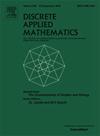On the twin-width of near-regular graphs
IF 1
3区 数学
Q3 MATHEMATICS, APPLIED
引用次数: 0
Abstract
Twin-width is a recently introduced graph parameter based on the repeated contraction of near-twins. It has shown remarkable utility in algorithmic and structural graph theory, as well as in finite model theory—particularly since first-order model checking is fixed-parameter tractable when a witness certifying small twin-width is provided. However, the behavior of twin-width in specific graph classes, particularly cubic graphs, remains poorly understood. While cubic graphs are known to have unbounded twin-width, no explicit cubic graph of twin-width greater than 4 is known.
This paper explores this phenomenon in regular and near-regular graph classes. We show that extremal graphs of bounded degree and high twin-width are asymmetric, partly explaining their elusiveness. Additionally, we establish bounds for circulant and -degenerate graphs, and examine strongly regular graphs, which exhibit similar behavior to cubic graphs. Our results include determining the twin-width of Johnson graphs over 2-sets, and cyclic Latin square graphs.
关于近正则图的双宽度
双生宽度是最近引入的基于近双生重复收缩的图参数。它在算法和结构图理论以及有限模型理论中显示出显著的效用-特别是因为当提供一个证明小双宽度的见证时,一阶模型检查是固定参数易于处理的。然而,双宽度在特定图类中的行为,特别是三次图,仍然知之甚少。虽然已知三次图具有无界双宽,但没有已知的双宽大于4的显式三次图。本文探讨了正则和近正则图类中的这一现象。我们证明了有界度和高双宽的极值图是不对称的,部分解释了它们的难以捉摸性。此外,我们建立了循环图和d-退化图的边界,并研究了表现出与三次图相似行为的强正则图。我们的结果包括确定2集上Johnson图的双宽度,以及循环拉丁平方图。
本文章由计算机程序翻译,如有差异,请以英文原文为准。
求助全文
约1分钟内获得全文
求助全文
来源期刊

Discrete Applied Mathematics
数学-应用数学
CiteScore
2.30
自引率
9.10%
发文量
422
审稿时长
4.5 months
期刊介绍:
The aim of Discrete Applied Mathematics is to bring together research papers in different areas of algorithmic and applicable discrete mathematics as well as applications of combinatorial mathematics to informatics and various areas of science and technology. Contributions presented to the journal can be research papers, short notes, surveys, and possibly research problems. The "Communications" section will be devoted to the fastest possible publication of recent research results that are checked and recommended for publication by a member of the Editorial Board. The journal will also publish a limited number of book announcements as well as proceedings of conferences. These proceedings will be fully refereed and adhere to the normal standards of the journal.
Potential authors are advised to view the journal and the open calls-for-papers of special issues before submitting their manuscripts. Only high-quality, original work that is within the scope of the journal or the targeted special issue will be considered.
 求助内容:
求助内容: 应助结果提醒方式:
应助结果提醒方式:


